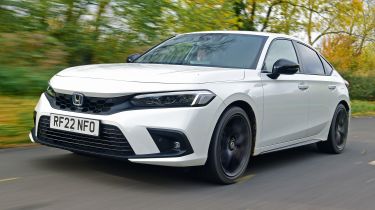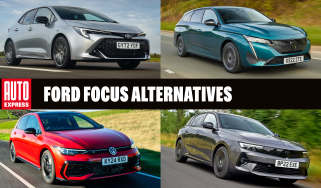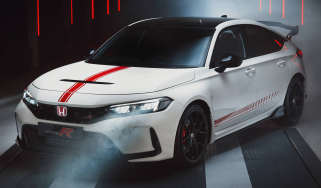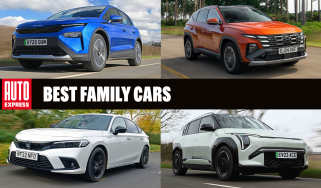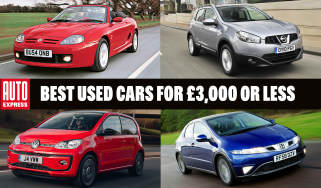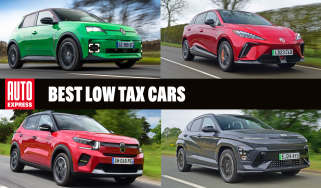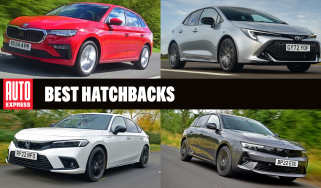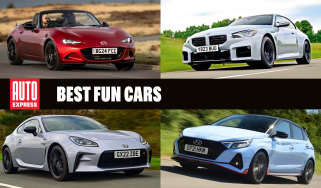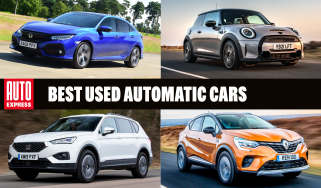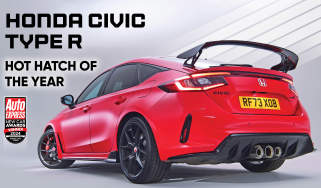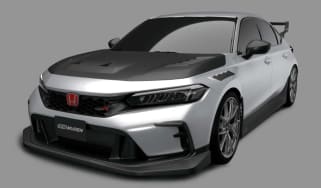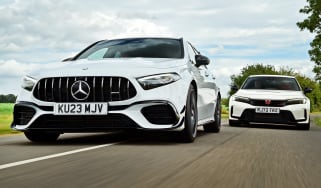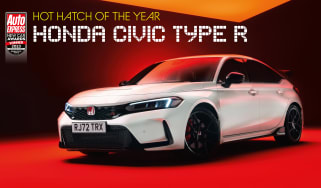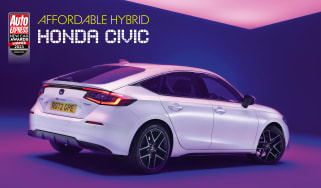Honda Civic review: a frugal, fun family hatch hybrid
The hybrid-powered Honda Civic is a frugal, well-equipped family hatchback that really impresses

What’s the best affordable hybrid? It’s the excellent Honda Civic, of course. Why? Well, it offers a highly efficient petrol and electric hybrid system that’ll appeal to those looking for lower running costs, and it’s still good to drive. Plus, it has an impressive amount of standard equipment along with lots of safety technology.
The Civic’s sleek hatchback lines offer some respite from the slew of SUVs and crossover-styled family cars that populate the UK car market. Sure, its sloping roofline won’t quite match the versatility of some of the boxier, more upright SUVs out there, but it’s practical enough for most needs. All things considered, the 11th generation is a worthy contender in its class.
About the Honda Civic
It’s 1972. Russia has landed its uncrewed Luna 20 spaceship on the moon, rock ‘n’ roll band T.Rex is riding high in the music charts, and Ford has just launched its new Granada executive car. Slipping under the radar, with a little less fanfare, was the introduction of Honda’s first-generation Civic – first as a two-door saloon, followed by the now more familiar hatchback model.
Fast forward more than fifty years and eleven model generations, and it’s fair to say that the Honda Civic has become a motoring mainstay in not just the UK, but around the world.
Used - available now

2021 Honda
Civic
26,605 milesManualPetrol1.0L
Cash £13,099
2021 Honda
Civic
46,152 milesAutomaticPetrol1.0L
Cash £15,708
2018 Honda
Civic
12,851 milesAutomaticPetrol1.5L
Cash £19,586
2021 Honda
Civic
54,839 milesAutomaticPetrol1.0L
Cash £12,900However, with families increasingly turning to SUVs and crossover-style cars to meet their everyday driving needs, the humble hatchback faces more competition than ever. Honda now only offers the Civic as a sensibly-styled five-door hatch to challenge rivals such as the great-handling Ford Focus, uber-practical Skoda Octavia, ever dependable (and equally hybrid) Toyota Corolla, plus the iconic Volkswagen Golf.
Other hatchback options for buyers include the great value Kia Ceed and Hyundai i30, the stylish-looking Mazda 3 and Peugeot 308, and the impressive SEAT Leon and Vauxhall Astra all being strong options. Those after a more premium model may wish to consider the Audi A3, BMW 1 Series, and Mercedes A-Class.
The Civic is powered by Honda's e:HEV hybrid technology with a 2.0-litre four-cylinder petrol engine under the bonnet, plus two electric motors to power the front wheels. The set-up produces a stout 181bhp and 315Nm of torque. For hot hatch fans, the stonking 325bhp Civic Type R is a high-performance weapon, having broken the front-wheel drive lap records at the Nurburgring race track in Germany and Japan's Suzuka race track.
Higher demand than expected for the Civic has led to short periods when certain trim levels weren’t available to order, but the range is back up to three now: Elegance, Sport and Advance. Entry-level cars are well-equipped, as you'd expect when prices start at nearly £35,000. Every Civic comes with 18-inch alloy wheels, LED headlights, keyless entry, a nine-inch touchscreen, reversing camera, and adaptive cruise control. Top-of-the-range Advance has a fully digital driver's display, heated leather steering wheel and panoramic glass roof.
Engines, performance and drive
While you won’t be setting any lap records like the Honda Civic Type R hot hatch, the standard Civic is still very satisfying to drive.
Find yourself on a more challenging A or B-road, and the Civic is pleasingly rewarding to drive. The front end feels pointy, with plenty of grip, and the weighty steering and good body control only add to the sense of agility.
The suspension tuning feels similar to what we’ve experienced in the Ford Focus (particularly ST-Line models), being just the right side of firm. Yes, it can feel a little fidgety on broken or uneven roads at low speeds, but when you get out of town, its excellent tuning takes the edge off sharp bumps or deep potholes well. At motorway speeds, the Civic feels supremely stable and avoids feeling floaty. The only true downside to the driving experience is the significant road noise generated by the large 18-inch wheels and wide tyres.
Like many electric cars, you can increase or decrease the strength of the regenerative braking system using paddles behind the steering wheel. You’ll notice the system working because it varies how quickly the vehicle slows when lifting the accelerator. The system isn’t strong enough for one-pedal driving, like you’ll find in a Nissan equipped with an e-Pedal system, but you’ll still get some satisfaction from using the regen to slow you down for a roundabout or help you filter in traffic without needing the brakes. We found this setting particularly handy around town and will probably save you money on replacement brake discs and pads in the long run. When you need them, the brakes feel strong and have a reassuring pedal feel.
The e-CVT transmission is smooth and works well, particularly during in-town driving, where the electric motor provides drive to the wheels.
0-62mph acceleration and top speed
While the Honda Civic Type R hot hatch uses a 2.0-litre turbocharged petrol engine paired with a traditional six-speed manual gearbox, the regular Civic is offered with a hybrid powertrain.
Called e:HEV, this hybrid set-up is similar to what you’ll find in the Honda ZR-V and Honda CR-V. It includes a small lithium-ion battery pack, two electric motors and a 2.0-litre Atkinson-cycle petrol engine. The hybrid system shifts between electric, engine power, or a combination of the two for maximum efficiency.
The e:HEV hybrid is straightforward to use, but a lot is happening behind the scenes. That 2.0-litre engine mostly works as a generator for the electricity that powers the electric motor driving the wheels. The upshot is you get an electric car's smooth, jerk-free progress, and the instant power of the electric motor makes the Civic feel sprightly at low speeds. Any electricity left over when the engine is on charges a modest 1.06kWh battery. That battery can allow you to drive for short distances at low speeds around town without using the engine if it has enough charge.
At higher speeds, the engine kicks in to generate more power, and the battery will provide a power boost when you need to accelerate quickly. The system always feels alert when you’re nipping into gaps in the traffic. Throttle response is strong, with none of the hesitancy we’ve experienced in the Dacia Jogger with its E-Tech hybrid system when asking for more power. Accelerating up to the national speed limit, the Civic feels quick; 0-62mph takes 7.9 seconds.
At motorway speeds, the engine is connected to the wheels in a fixed gear ratio. Think of it like putting a regular petrol or diesel car into top gear, with the benefit of this being that unlike a Toyota Corolla with its e-CVT system, which sends the revs soaring when you need to accelerate, the Honda system doesn’t, and behaves much like a normal automatic gearbox.
MPG, CO2 and running costs
The Civic’s sole e:HEV petrol hybrid system makes it a frugal performer, managing 56.5mpg on the WLTP combined cycle, with CO2 emissions from 108g/km. Our experience with the 11th-generation Civic shows that achieving impressive fuel economy figures shouldn’t be too difficult in everyday driving.
For instance, during our group test between the latest Honda Civic, Toyota Corolla and Kia Ceed, the Honda returned 50.3mpg, compared to the Toyota's 54.2mpg and 43.5mpg we saw from the Kia. And when we ran a Civic in Sport trim as a long-term test car, after nearly 6,000 miles (of which a significant proportion was in town traffic), we averaged a respectable 45.1mpg.
But, without a plug-in hybrid version or the availability of an all-electric Civic model, company car drivers are less likely to opt for Honda’s evergreen hatchback than the Peugeot 308 or Vauxhall Astra. Also, while the Civic has lower emissions than a regular petrol or diesel car, its higher starting price than a Ford Focus or Volkswagen Golf may count against it when calculating its Benefit-in-Kind tax rate.
Insurance
All Civic models sit in group 28 (out of 50) for insurance, so premiums will be reasonably expensive compared with rivals such as the Ford Focus and Volkswagen Golf. The more powerful 276bhp Focus ST is in group 27, while a mid-range 153bhp Focus Titanium X model is in group 19. Even the 296bhp Golf GTI Clubsport is in group 29, which means that – from an insurance perspective – the Civic doesn’t represent the best value.
Check any car's MoT history in a few easy clicks with our MoT checker tool...
Depreciation
Buyers will be pleased that early indications are that the Civic will hold onto a decent chunk of its original value after a typical three-year/36,000-mile ownership period. All models should be worth around 50 per cent of their showroom sticker price after this time, which compares similarly to the VW Golf.
The only downside for the Civic is that the Corolla, in either Excel or GR Sport form, will be worth almost 57 per cent of its value after the same time and mileage period, and it is cheaper to buy in the first place.
To get an accurate valuation on a specific model check out our free car valuation tool...
Interior, design and technology
Honda has smoothed out the angular lines of the previous Civic model, providing the 11th iteration of its family hatchback with a cleaner look, increased glasshouse and a longer, sleeker profile. It looks handsome and offers a more cohesive design than its predecessor.
Inside, the cabin benefits from a noticeable step up in perceived quality. Regular touch points feel more upmarket, while the seats in Advance models are upholstered in black leather trim. Everything feels as tightly screwed together as any premium offering the Civic will go up against.
Honda engineers have kept easy-to-use physical climate controls for the interior of the Civic, and have wisely avoided using the touch-sensitive buttons or sliders we’ve found to be hugely frustrating on the VW Golf. There’s a similarly pragmatic approach throughout the cabin with well-placed cupholders, USB ports and drive mode selector buttons on the centre console that are easy to use.
Sat-nav, stereo and infotainment
At nine inches, the Civic's touchscreen is marginally smaller than the unit featured in its rivals like the Kia Ceed, Toyota Corolla or Vauxhall Astra. However, the interface is neat, and there’s a logical main menu comprising two rows of shortcut icons. If you’re used to previous Civics, it’s a huge improvement, but it’s still not quite a class-leading system.
In our opinion, the graphics look a little dated, and when we pitted the 11th-generation Civic against the Corolla, the Honda’s system couldn't load as quickly. At least Android Auto and Apple CarPlay connectivity is standard, plus there are useful USB ports in the front and rear of the cabin.
It’s great that Honda has kept some shortcut keys along the base of the screen to make it easier to use on the move than rivals such as the Golf. The part-digital dials on the Elegance and Sport models are clear enough and easy to read, while the top-of-the-range Advance trim gets a 10.2-inch fully digital driver’s display. An upgraded Bose 12-speaker audio system comes on the range-topping model also.
Practicality, comfort and boot space
Honda has focused on making the 11th-generation Civic a more practical car – possibly to combat the stream of SUVs that have flooded the UK family car market. It has increased cabin space compared to the previous model, a bigger glasshouse that helps improve visibility.
You sit fairly low in the Civic compared with a Toyota Corolla, but a pair of six-footers will find enough space up front. It's nice that electric lumbar adjustment is standard to improve comfort for the driver (you’ll need an Advance model to get electric passenger lumbar adjustment), but the Civic has an annoying lever you need to pull to adjust the backrest, which isn’t as easy to fine-tune as the dial used by most of its rivals, including the Ford Focus and VW Golf.
Storage is decent up front, though. There’s a large central bin, a pair of deep cup holders and a large smartphone shelf. The door pockets are larger than the Corolla’s, but not as wide as in the Vauxhall Astra.
Dimensions and size
At 4,551mm long and 1,802mm wide, the Civic occupies a sizable footprint for a five-door hatchback. It has an increased wheelbase over the previous model to help create more interior space, while its overall height has been reduced to give a sleeker look.
For comparison purposes, a Volkswagen Golf measures 4,284mm long and 1,789mm wide, while the Kia Sportage family SUV is 4,515mm long and 1,865mm wide.
Leg room, head room & passenger space
Passengers in the rear seats aren’t as well catered for as those in the front. Headroom is average, and buyers used to an SUV's raised seating position and higher roof line might feel this too impractical. In our experience during a group test between the 11th-generation Civic, the Kia Ceed and Toyota Corolla, the Civic’s headroom was a little tight compared to the Ceed and Corolla.
That said, the Honda offered the most legroom of the three. However, if maximum legroom is what you’re after, consider the roomier Skoda Octavia.
Boot space
The Civic has a 410-litre boot, which is 35 litres bigger than a Focus and 30 litres more than a Golf. Consider the Octavia for outright capacity, because, in its hatchback form, it has a monster 600-litre boot. If you don’t mind the ubiquitous style of a family SUV, then you might want to consider the Kia Sportage or Hyundai Tucson; the closely related mid-size SUVs offer 591 litres and 620 litres, respectively.
Towing
Buyers looking to use their car to tow trailers or caravans will probably need to look elsewhere because the Civic only has a maximum braked trailer weight of 750kg. In that instance, you’ll have to look at the plug-in hybrid Astra with its 1,450kg braked towing limit, or a traditionally powered 2.0-litre diesel Golf, because that’ll pull up to 1,600kg.
Reliability and safety
The 11th-generation Civic was awarded the maximum five-star safety rating by Euro NCAP in 2022, receiving impressive 89 and 87 per cent scores in the adult and child occupant protection categories, respectively. The Civic is a whole star ahead of the latest Peugeot 308 and Vauxhall Astra, and it protects vulnerable road users and has better accident avoidance technology than the VW Golf and Skoda Octavia.
All versions feature the same high levels of active safety kit, with a departure warning system that also includes a lane assist function to help keep you within your lane; there’s traffic sign recognition that (among other things) lets you know the current speed limit of the road you’re on, a forward collision warning to let you know if it thinks you’re about to hit something ahead of you, autonomous emergency braking (AEB) to help mitigate or prevent collisions at low speed with other vehicles or vulnerable road users, a blind spot information system that’ll warn you of any cars following alongside on the motorway, and a cross-traffic monitoring system to let you know of vehicles crossing your path should you be reversing onto a main road, or trying to edge out of a junction you can easily see what’s approaching. There’s even a traffic jam assist function, which uses a combination of radar and camera systems to detect vehicles ahead and maintain an appropriate speed.
The latest Civic is too new to have featured in our 2023 Driver Power customer satisfaction survey. Honda, as a brand, managed a mediocre 18th place out of 32 manufacturers. That puts it below Hyundai, Toyota and Kia, but above Nissan, Skoda, VW, Ford, and Renault.
Warranty
All new Hondas come with a three-year/90,000-mile warranty, which is a little behind the curve compared to the seven-year cover offered by Kia and the ten-year warranty package provided by Toyota. Civic buyers can extend their warranty for an additional one or two years – or as part of an add-on to a five-year service plan (more about that in the next section).
The cost is either £499 for an additional year, or £899 for two years.
Servicing
Servicing limits haven’t been mentioned yet, but going by the terms and conditions of Honda’s five-year servicing plan, the Civic will most likely need servicing annually or every 12,500 miles.
Speaking of the service plan, you can purchase a five-year policy (transferable to subsequent owners) for £799, and you could add the Customer Care Package add-on to that for an additional £399 to extend the warranty and roadside assistance policies up to five years.
